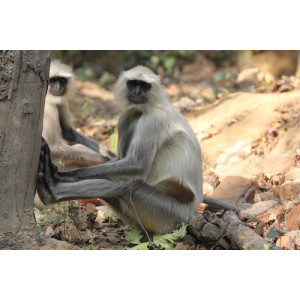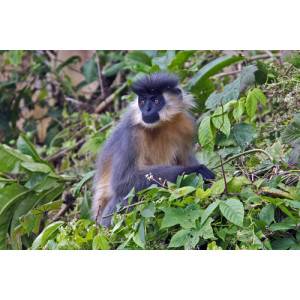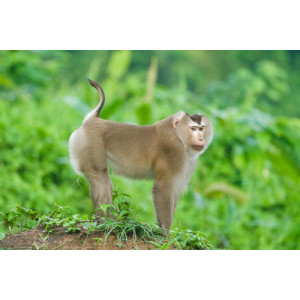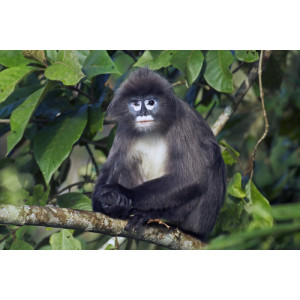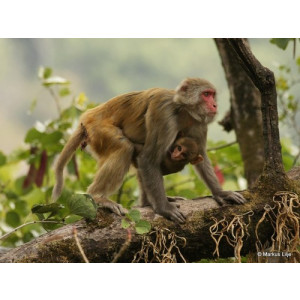Stump-tailed Macaque Did you see this animal?
Scientific Name : Macaca arctoides
Family : Cercopithecidae
Order : Primates
Class : Mammalia
Phylum : Chordata
Other Name : Stumptail Macaque, Bear Macaque
Habitat : Forest
Description : Stump-tailed macaques are medium-sized primates that typically weigh between 4 and 8 kilograms (8.8 to 17.6 pounds) and have a body length of 40 to 60 centimeters (16 to 24 inches). They have dark brown fur with a paler underside, a short tail, and a prominent brow ridge.
These monkeys are social animals that live in groups of up to 50 individuals, with females usually outnumbering males. They are omnivores, feeding on a variety of plant materials, as well as insects, small mammals, and bird eggs.
Stump-tailed macaques are known for their intelligence and adaptability. They have been observed using tools, such as using rocks to crack open hard-shelled nuts, and have also been shown to exhibit self-awareness in mirror tests.
In their natural habitats, stump-tailed macaques live in a variety of forested areas, from primary rainforest to disturbed and secondary forests. They are also known to inhabit agricultural areas, where they can cause crop damage and conflict with humans.
Like other macaque species, stump-tailed macaques have a complex social structure. Dominance hierarchies exist within groups, and individuals may form strong social bonds with others. Females are typically the primary caregivers of offspring, and both males and females may participate in communal care of young.
Stump-tailed macaques are threatened by habitat loss and fragmentation due to deforestation, as well as hunting and capture for the pet trade. In some areas, they are also considered a pest species due to their crop-raiding behavior. Conservation efforts are focused on protecting their remaining habitats and addressing human-wildlife conflicts to minimize negative interactions between humans and macaques.
Stump-tailed macaques are classified as a vulnerable species due to habitat loss and fragmentation, as well as hunting for meat and the pet trade. Conservation efforts are underway to protect their populations and their habitats.
These monkeys are social animals that live in groups of up to 50 individuals, with females usually outnumbering males. They are omnivores, feeding on a variety of plant materials, as well as insects, small mammals, and bird eggs.
Stump-tailed macaques are known for their intelligence and adaptability. They have been observed using tools, such as using rocks to crack open hard-shelled nuts, and have also been shown to exhibit self-awareness in mirror tests.
In their natural habitats, stump-tailed macaques live in a variety of forested areas, from primary rainforest to disturbed and secondary forests. They are also known to inhabit agricultural areas, where they can cause crop damage and conflict with humans.
Like other macaque species, stump-tailed macaques have a complex social structure. Dominance hierarchies exist within groups, and individuals may form strong social bonds with others. Females are typically the primary caregivers of offspring, and both males and females may participate in communal care of young.
Stump-tailed macaques are threatened by habitat loss and fragmentation due to deforestation, as well as hunting and capture for the pet trade. In some areas, they are also considered a pest species due to their crop-raiding behavior. Conservation efforts are focused on protecting their remaining habitats and addressing human-wildlife conflicts to minimize negative interactions between humans and macaques.
Stump-tailed macaques are classified as a vulnerable species due to habitat loss and fragmentation, as well as hunting for meat and the pet trade. Conservation efforts are underway to protect their populations and their habitats.
Distribution in Bangladesh
References:
description written by: Asad U. Tanvir, Department of Zoology, Jagannath University, Dhaka; reviewed by: Muntasir Akash, Department of Zoology, University of Dhaka; Taxonomic Checklist: Red List of Bangladesh Volume 2: Mammals, 2015, IUCN; information sources: iucnredlist.org, Khan 2018 (Photographic guide to the wildlife of Bangladesh), photo credit: Hector Manuel Zazueta Islas (www.inaturalist.org/people/ericblanc), photo copyright: iNaturalist. For more information please contact with us.
description written by: Asad U. Tanvir, Department of Zoology, Jagannath University, Dhaka; reviewed by: Muntasir Akash, Department of Zoology, University of Dhaka; Taxonomic Checklist: Red List of Bangladesh Volume 2: Mammals, 2015, IUCN; information sources: iucnredlist.org, Khan 2018 (Photographic guide to the wildlife of Bangladesh), photo credit: Hector Manuel Zazueta Islas (www.inaturalist.org/people/ericblanc), photo copyright: iNaturalist. For more information please contact with us.

